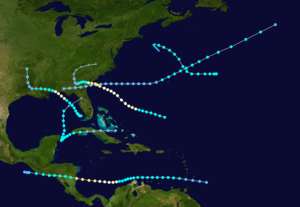| 1911 Atlantic hurricane season | |
|---|---|
 Season summary map | |
| Seasonal boundaries | |
| First system formed | February 19, 1911 |
| Last system dissipated | December 13, 1911 |
| Strongest storm | |
| Name | Three |
| • Maximum winds | 100 mph (155 km/h) (1-minute sustained) |
| • Lowest pressure | 972 mbar (hPa; 28.7 inHg) |
| Seasonal statistics | |
| Total depressions | 9 |
| Total storms | 6 |
| Hurricanes | 3 |
| Total fatalities | >27 |
| Total damage | $3 million (1911 USD) |
| Related articles | |
The 1911 Atlantic hurricane season was a relatively inactive hurricane season, with only six known tropical cyclones forming in the Atlantic during the summer and fall. There were three suspected tropical depressions, including one that began the season in February and one that ended the season when it dissipated in December. Three storms intensified into hurricanes, two of which attained Category 2 status on the modern-day Saffir–Simpson Hurricane Scale. Storm data is largely based on the Atlantic hurricane database, which underwent a thorough revision for the period between 1911 and 1914 in 2005.
Most of the cyclones directly impacted land. A westward-moving hurricane killed 17 people and severely damaged Charleston, South Carolina, and the surrounding area in late August. A couple of weeks earlier, the Pensacola, Florida area had a storm in the Gulf of Mexico that produced winds of 80 mph (130 km/h) over land. The fourth storm of the season struck the coast of Nicaragua, killing 10 and causing extensive damage.